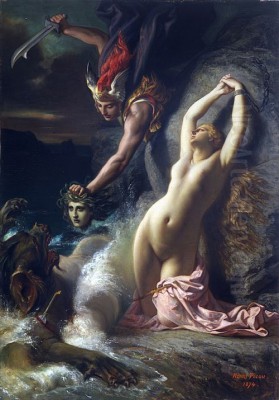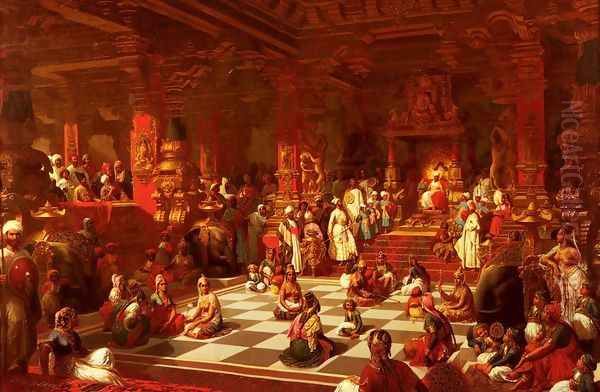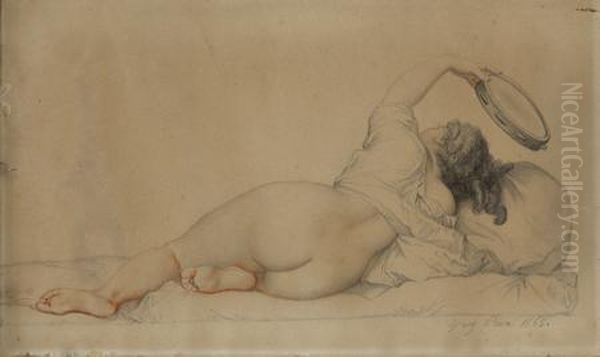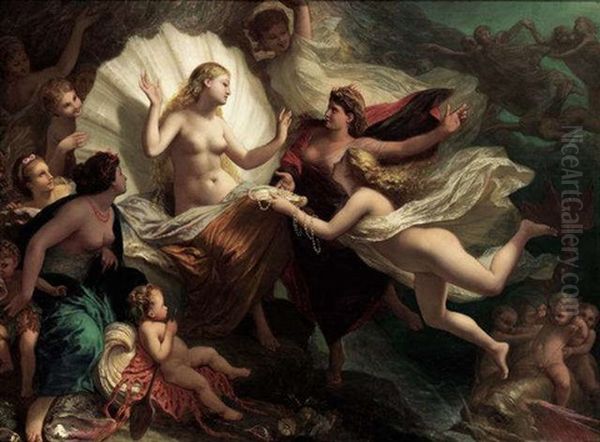
Henri Pierre Picou stands as a significant, though sometimes overlooked, figure in the landscape of nineteenth-century French art. Born in Nantes on February 27, 1824, and passing away in his native city on July 17, 1895, Picou's career spanned a dynamic period of artistic evolution in France. He is primarily recognized as one of the founding members of the Neo-Grec school, an artistic movement that sought to blend classical aesthetics with modern sensibilities. Working adeptly across genres, Picou produced compelling portraits, grand historical scenes, and, most notably, evocative mythological and allegorical compositions that captured the imagination of his contemporaries.
His artistic journey began under the tutelage of respected masters and culminated in a distinctive style that, while rooted in academic tradition, possessed a unique charm and eclecticism. Picou became a fixture at the prestigious Paris Salon for decades, earning accolades and securing important commissions, cementing his place within the artistic establishment of the Second Empire and the early Third Republic. This exploration delves into the life, work, and enduring legacy of Henri Pierre Picou, examining his artistic formation, his pivotal role in the Neo-Grec movement, his signature style, key works, and his position within the broader context of nineteenth-century art history.
Early Life and Artistic Formation
Henri Pierre Picou's artistic inclinations led him from his birthplace in Nantes to the vibrant art world of Paris. His formal training began under the esteemed history painter Paul Delaroche. Delaroche's studio was a crucible for many aspiring artists, known for its emphasis on historical accuracy, dramatic composition, and polished finish – elements that would surface in Picou's own early works. Delaroche's meticulous approach to historical subjects undoubtedly provided Picou with a strong foundation in academic technique and narrative painting.

However, it was perhaps his subsequent studies with the Swiss-born painter Charles Gleyre that proved most formative for Picou's specific artistic direction. Gleyre's atelier, which he took over from Delaroche, became a breeding ground for innovation within the academic framework. Gleyre encouraged a more personal interpretation of classical themes, often imbued with a sense of poetry and idealism. He fostered an environment where precision of line, clarity of form, and an interest in archaeological detail, particularly inspired by discoveries at Pompeii and Herculaneum, were highly valued. It was within Gleyre's studio that Picou connected with like-minded artists who would become his collaborators in forging a new artistic path.
The Birth of the Neo-Grec School
The late 1840s witnessed the emergence of the Neo-Grec (Neo-Greek) school, a movement intrinsically linked with Picou and his fellow students from Gleyre's studio. Alongside Picou, the key figures in this development were Jean-Léon Gérôme, Gustave Boulanger, and Jean-Louis Hamon. These young artists shared a fascination with classical antiquity, but sought to move beyond the stern Neoclassicism of Jacques-Louis David or the Romantic interpretations of the previous generation. They aimed for a style that was archaeologically informed yet lighter, more decorative, and often focused on intimate, everyday scenes from the ancient world, rather than solely grand historical or mythological events.
Their shared artistic vision was nurtured not only in the studio but also through close personal association. For a period, Picou, Gérôme, and Hamon reportedly shared lodgings or worked in close proximity, fostering an environment of mutual influence and collaborative spirit sometimes referred to informally as the "École Gérôme" due to Gérôme's later prominence. The Neo-Grec style they developed was characterized by sharp linearity, precise detail, smooth surfaces, often bright, clear colours, and subjects drawn from Greek and Roman life, frequently depicted with a touch of whimsy, sentimentality, or gentle eroticism. It represented a sophisticated, eclectic blend, drawing inspiration from Greek vase painting, Pompeian frescoes, and the refined classicism of artists like Jean-Auguste-Dominique Ingres, albeit applied to different ends.
Salon Success and Early Recognition
Picou made a significant impact early in his career. His official debut at the Paris Salon occurred in 1847 with the painting Cléopâtre et Antoine sur le Cydnus (Cleopatra and Antony on the Cydnus). This work, depicting the famous meeting of the Egyptian queen and the Roman general, was well-received and earned Picou a second-class medal. Critics, potentially including the influential Théophile Gautier or Ferdinand Georges, noted its skillful execution and appealing subject matter, marking Picou as a talent to watch. This success firmly established him within the competitive Salon system.

His reputation was further solidified in 1853 when he was awarded a prestigious Second Prix de Rome for his painting Jésus chassant les marchands du Temple (Christ Driving the Moneychangers from the Temple). While not the First Prize, which guaranteed years of study in Rome, the Second Prize was still a significant honour, confirming his mastery of large-scale historical and religious composition according to academic standards. This painting remains in the collection of the École nationale supérieure des Beaux-Arts in Paris, a testament to his academic achievements. Following these early successes, Picou became a regular and consistent exhibitor at the Salon, presenting works almost annually until his withdrawal in 1893.
Artistic Style and Thematic Evolution
Initially grounded in portraiture and historical subjects, Picou's artistic focus gradually shifted towards the allegorical and mythological themes that would define much of his mature work. His style evolved into what has been described as an "eclectic polychrome mix." This involved skillfully blending elements from various sources: the precision and idealized forms of Neoclassicism, the decorative motifs and intimate scale inspired by Pompeian art, the elegance associated with the English Adam style, and even echoes of Egyptian Revival aesthetics. This eclecticism distinguished his work from stricter academic painters.
Picou's paintings often possess a distinct atmosphere. While technically precise and smoothly finished, they frequently convey a sense of mystery, fantasy, or gentle sensuality. His mythological scenes are less about heroic drama and more about lyrical beauty, decorative arrangement, and the exploration of symbolic meaning. He favoured subjects that allowed for the depiction of idealized figures, often female nudes, set within harmonious, sometimes dreamlike, landscapes or interiors. His colour palettes could range from clear and bright in his Neo-Grec works to richer, more atmospheric tones in later allegorical pieces. This blend of academic technique with a more imaginative, sometimes Symbolist-leaning sensibility, set him apart from contemporaries like the highly polished William-Adolphe Bouguereau or the historically focused Jean-Léon Gérôme, even while sharing common roots.
Analysis of Major Works
Several key works illustrate the development and characteristics of Picou's art:
Cléopâtre et Antoine sur le Cydnus (1847): His Salon debut piece showcased his ability to handle complex historical subjects with decorative flair. The depiction likely emphasized the opulence and seduction of the encounter, aligning with the Neo-Grec taste for visually rich and somewhat theatrical interpretations of antiquity. Its critical success immediately positioned him as a proponent of this emerging style.
Jésus chassant les marchands du Temple (1853): Winning the Second Prix de Rome, this work demonstrated Picou's command of traditional religious painting required by the Academy. It likely featured dynamic composition and expressive figures, proving his versatility beyond the more intimate Neo-Grec scenes.

The Judgment of Paris (undated): A classic mythological subject favoured by academic painters, this theme allowed Picou to explore the idealized female form. His interpretation likely focused on the graceful poses and harmonious composition characteristic of his style, presenting the goddesses Venus, Juno, and Minerva not just as rivals, but as elements in a beautifully orchestrated visual arrangement.
Andromeda Chained to a Rock (e.g., 1874 version): This subject, which he revisited, exemplifies his mature style. Critics noted a combination of classical beauty in the figure of Andromeda with a lightness and grace reminiscent of the Rococo era. This fusion of academic form with a lighter, more decorative sensibility is a hallmark of Picou's unique approach to mythology.
Jeu d'échecs Indien (Indian Chess Game) (1876) and Odalisque (1858): These works show Picou engaging with Orientalist themes, a popular trend in nineteenth-century French art, famously explored by artists like Ingres, Eugène Delacroix, and his friend Gérôme. While perhaps less central to his oeuvre than classical mythology, these paintings demonstrate his interest in exotic subjects and decorative possibilities offered by non-Western settings and costumes.
Religious and Decorative Commissions
Beyond his Salon paintings, Picou also undertook significant commissions for religious and decorative works. He received commissions to create large-scale murals for several churches, most notably the Church of Saint-Roch in Paris. This aspect of his career highlights his standing within the official art establishment, as such commissions were typically awarded to respected academic painters.
These religious works required a different approach than his mythological scenes, demanding a greater sense of solemnity and adherence to iconographic traditions. However, Picou likely brought his characteristic refinement and compositional skill to these projects. His involvement in church decoration places him in the company of other prominent muralists of the era, such as Hippolyte Flandrin or Pierre Puvis de Chavannes, although Picou's style remained distinct, generally more detailed and less stylized than that of Puvis de Chavannes. This facet of his work underscores his versatility and his ability to adapt his skills to the demands of large-scale public art.
Studio, Later Career, and Contemporaries
As a successful artist, Picou maintained a large studio on the Boulevard de Magenta in Paris. This substantial workspace would have been necessary for producing the large canvases destined for the Salon and his mural commissions. It signified his professional success and integration into the Parisian art scene. He remained a consistent presence at the Salon throughout the 1870s and 1880s, adapting his style subtly over time but remaining largely faithful to his core aesthetic principles rooted in classicism and allegory. His participation ceased only in 1893, just two years before his death.
Picou's career unfolded amidst a constellation of diverse artistic talents. He was, of course, closely linked to his Neo-Grec collaborators Gérôme, Boulanger, and Hamon, and shared teachers in Delaroche and Gleyre. He worked during the towering presence of Ingres, whose influence on line and form permeated academic circles. He exhibited alongside the giants of High Academicism, William-Adolphe Bouguereau and Alexandre Cabanel, whose polished mythological and historical scenes often dominated the Salons. His interest in symbolism connected him thematically, if not always stylistically, to Gustave Moreau. He was a contemporary of muralists like Puvis de Chavannes, portraitists like Léon Bonnat, and artists bridging Romanticism and Classicism like Théodore Chassériau. He also witnessed the rise of radically different movements, exhibiting at the same Salons that eventually, and often grudgingly, included works by Édouard Manet and the Impressionists like Edgar Degas. While distinct from them, Picou's work provides context for the diversity of art produced during this period, existing alongside artists like James Tissot or even the later classicist Lawrence Alma-Tadema in Britain, who shared a similar interest in detailed historical settings.
Influence and Legacy
Henri Pierre Picou's primary influence lies in his role as a co-founder and key practitioner of the Neo-Grec style. This movement offered a fresh, accessible, and often charming interpretation of classical antiquity that found favour with collectors and critics in the mid-nineteenth century. While perhaps overshadowed in popular memory by the later fame of his colleague Jean-Léon Gérôme, Picou was instrumental in shaping the group's early direction and aesthetic. His work exemplified the movement's blend of archaeological detail, refined technique, and imaginative subject matter.
The Neo-Grec school itself represented an important, if relatively short-lived, phase within French academic art, bridging the gap between stricter Neoclassicism and later academic trends. Picou's emphasis on allegory and symbolism also connects his work to the broader Symbolist currents that gained momentum towards the end of the century. Though his style fell out of fashion with the rise of Impressionism and subsequent modernist movements, his work has seen renewed interest as part of a broader reassessment of nineteenth-century academic art.
Today, Picou's paintings are held in various public collections, including the Musée d'Orsay in Paris, the Musée d'Arts de Nantes (his hometown), and the Dallas Museum of Art, among others. These works stand as testaments to his technical skill, his imaginative interpretations of myth and history, and his significant contribution to the Neo-Grec movement. He remains an important figure for understanding the complexities and diversity of French art during a period of profound change.
Conclusion
Henri Pierre Picou navigated the demanding art world of nineteenth-century France with considerable skill and a distinctive artistic vision. As a founding member of the Neo-Grec school, he helped forge a style that brought classical themes to life with a new intimacy and decorative elegance. His paintings, characterized by their technical polish, eclectic blend of influences, and often dreamlike or symbolic qualities, earned him recognition at the Salon and important commissions. While rooted in the academic tradition taught by Delaroche and Gleyre, his work possessed a personal charm and imaginative flair that set it apart. Though perhaps less renowned today than some of his contemporaries like Gérôme or Bouguereau, Picou remains a key figure for appreciating the nuances of academic art in the Second Empire and early Third Republic, representing a unique fusion of classical ideals and modern sensibilities. His legacy endures in his captivating canvases, which continue to offer insight into the artistic tastes and cultural preoccupations of his time.